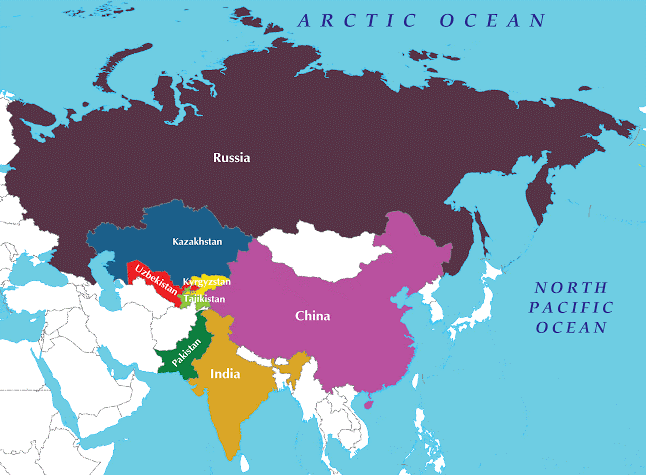CONTENTS
- Shanghai Cooperation Organisation
- Malabar naval exercise
Shanghai Cooperation Organisation
Focus: GS II: International Relations
Why in News?
The Ministry of Skill Development and Entrepreneurship (MSDE) organised a seminar on Building Capacities through skill training and New Generation of Entrepreneurs in Shanghai Cooperation Organisation (SCO) Partner Nations towards usage and set up of digital IT platforms.
What is the SCO?
- Founded in June 2001, it was built on the ‘Shanghai Five’, the grouping which consisted of Russia, China, Kazakhstan, Kyrgyzstan and Tajikistan.
- They came together in the post-Soviet era in 1996, in order to work on regional security, reduction of border troops and terrorism.
- They endowed particular focus on ‘conflict resolution’, given its early success between China and Russia, and then within the Central Asian Republics.
- Some of their prominent outcomes in this arena entail an ‘Agreement on Confidence-Building in the Military Field Along the Border Areas’ (in 1996) between China, Russia, Kazakhstan, Kyrgyzstan and Tajikistan, which led to an agreement on the mutual reduction of military forces on their common borders in 1997.
- It would also pitch in to help the Central Asian countries resolve some of their boundary disputes.
- In 2001, the ‘Shanghai Five’ inducted Uzbekistan into its fold and named it the SCO, outlining its principles in a charter that promoted what was called the “Shanghai spirit” of cooperation.
- The precise assertion, combined with some of the member states’ profiles, of building a “new international political and economic order” has often led to it being placed as a counter to treaties and groupings of the West, particularly North Atlantic Treaty Organisation (NATO).
Member states

- India, Kazakhstan, China, Kyrgyzstan, Pakistan, Russia, Tajikistan and Uzbekistan.
- The SCO also has four observer states — Afghanistan, Iran, Belarus and Mongolia — of which Iran and Belarus are now moving towards full membership.
Main goals
- Strengthening mutual trust and neighbourliness among the member states;
- Promoting their effective cooperation in politics, trade, economy, research and technology, and culture.
Focus areas:
- Education, energy, transport, tourism and environmental protection.
- It also calls for joint efforts to maintain and ensure peace, security and stability in the region; and the establishment of a democratic, fair and rational new international political and economic order.
Organizational structure of SCO
The SCO secretariat has two permanent bodies —
- SCO Secretariat based in Beijing
- Executive Committee of the Regional Anti-Terrorist Structure (RATS) based in Tashkent.
Other than this, the grouping consists of
Heads of State Council (HSC):
- It is the supreme decision-making body of the organisation.
- It meets annually to adopt decisions and guidelines on all important matters relevant to the organisation.
Heads of Government Council (HGC):
- The HGC (mainly including Prime Ministers) also meets annually to zero in on the organisation’s priority areas and multilateral cooperation strategy.
- It also endeavours to resolve present economic and cooperation issues alongside approving the organisation’s annual budget.
Foreign Ministers Council:
- The Foreign Ministers Council considers issues pertaining to the day-to-day activities of the organisation, charting HSC meetings and consultations on international problems within the organisation and if required, makes statements on behalf of the SCO.
Malabar Naval Exercise
Focus: GS III: Security Challenges
Why in News?
The Malabar naval exercise, the most visible manifestation of the expanding military interoperability among the Quad countries, will be conducted off Australia for the first time this August.
About Malabar naval exercise
- The Malabar naval exercise is a bilateral naval exercise between India and the US Navy that started in 1992.
- The exercise was expanded into a trilateral format with the inclusion of Japan in 2015.
- In 2020, the Australian Navy joined the Malabar Exercise, making it a quadrilateral naval exercise.
- The first Malabar Exercise in the Bay of Bengal took place in 2007.
- The aim of the Malabar Exercise of India, the US, Japan and Australia is to coordinate for a free, open, and inclusive Indo-Pacific.
- The exercise takes place annually in the Indian Ocean and Pacific Oceans alternatively.
- The Malabar Exercise includes a diverse range of activities such as fighter combat operations and maritime interdiction operations.





